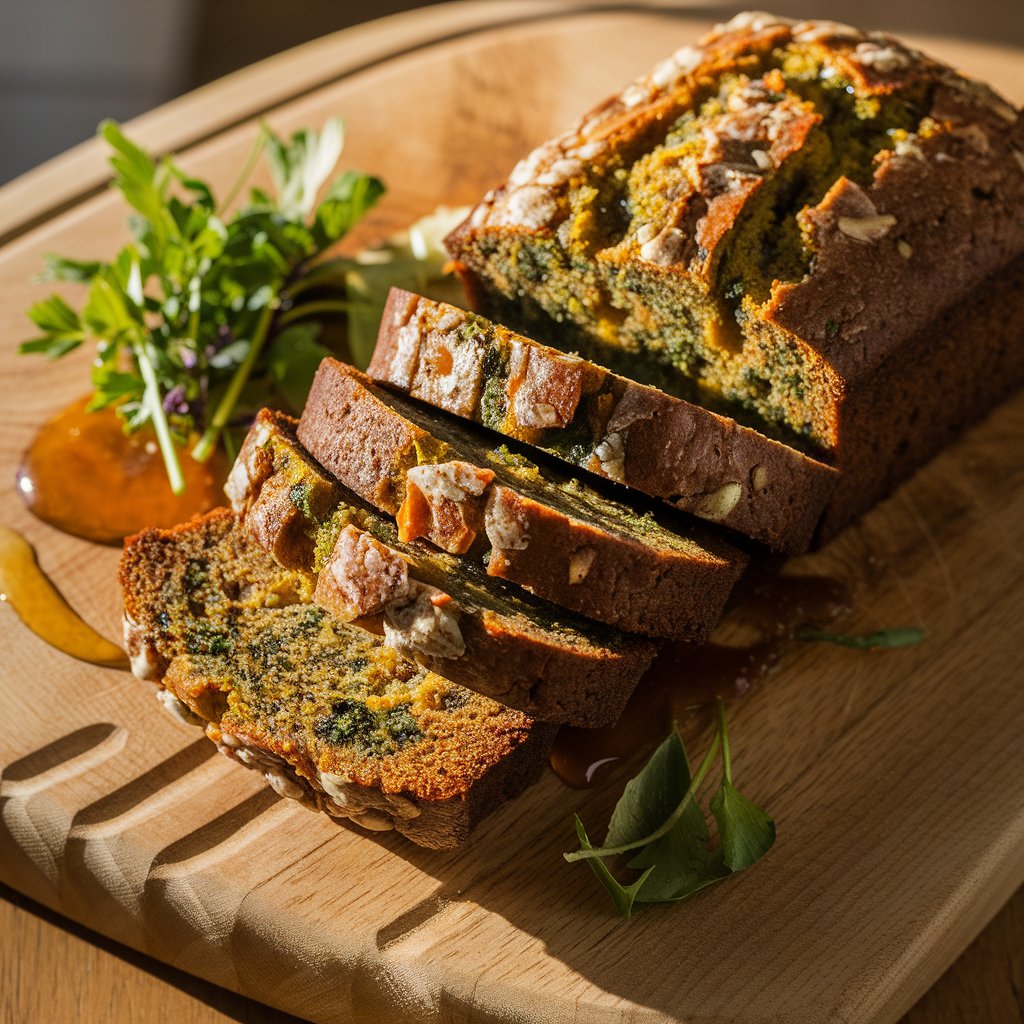Zucchini bread is a classic favorite, loved for its moist texture, subtle sweetness, and the hidden veggie goodness it offers. However, for those with gluten sensitivities or celiac disease, finding a gluten-free version that doesn’t compromise on flavor or texture can be a challenge. This gluten-free zucchini bread recipe is here to change that! Packed with nutrients and free of gluten, it’s the perfect treat for breakfast, a snack, or even dessert. Let’s dive into how you can make this delightful bread at home.
Table of Contents
- Introduction
- Ingredients and Their Benefits
- Step-by-Step Instructions
- Tips for Success
- Variations of Gluten-Free Zucchini Bread
- Nutritional Insights
- Storing and Serving Suggestions
- Frequently Asked Questions (FAQs)
- Conclusion
Introduction
Zucchini bread is a versatile and healthy option for those looking to enjoy a sweet treat without the guilt. It’s naturally moist thanks to the zucchini, and when made gluten-free, it becomes an inclusive option for those with dietary restrictions. Whether you’re new to gluten-free baking or a seasoned pro, this recipe is easy to follow and delivers consistently delicious results.
Ingredients and Their Benefits
For this gluten-free zucchini bread, you’ll need the following ingredients:
- 2 cups grated zucchini: Zucchini adds moisture to the bread, making it tender and soft. It’s also rich in vitamins A, C, and K, as well as antioxidants that are great for your health.
- 1 ½ cups gluten-free flour blend: A good gluten-free flour blend will typically include a mix of rice flour, tapioca starch, and potato starch. This combination mimics the texture of all-purpose flour without the gluten, ensuring a fluffy and light bread.
- 1 teaspoon baking soda: Baking soda acts as a leavening agent, helping the bread rise and achieve a nice, airy texture.
- ½ teaspoon baking powder: Baking powder complements the baking soda, ensuring the bread rises evenly and doesn’t become too dense.
- 1 teaspoon ground cinnamon: Cinnamon adds a warm, sweet spice that pairs perfectly with the zucchini and sugar.
- ½ teaspoon ground nutmeg: Nutmeg provides a slightly nutty flavor, adding depth to the overall taste of the bread.
- ½ teaspoon salt: Salt enhances the flavors of the other ingredients and balances the sweetness.
- ¾ cup granulated sugar: Sugar sweetens the bread just enough without overpowering the natural flavors of the zucchini and spices.
- ¼ cup brown sugar: Brown sugar adds a hint of caramel flavor and additional moisture to the bread.
- 2 large eggs: Eggs help bind the ingredients together and add richness to the bread’s texture.
- ½ cup vegetable oil or melted coconut oil: Oil keeps the bread moist and tender, preventing it from drying out.
- 1 teaspoon vanilla extract: Vanilla extract enhances the flavor of the bread, adding a subtle sweetness and aroma.
- Optional: ½ cup chopped nuts or chocolate chips: For added texture and flavor, you can mix in chopped nuts like walnuts or pecans, or even chocolate chips for a more indulgent treat.
Ingredient Benefits Breakdown:
- Zucchini: Besides adding moisture, zucchini is low in calories but high in essential nutrients like potassium, manganese, and dietary fiber. It’s also known to promote digestion and support a healthy immune system.
- Gluten-Free Flour Blend: Using a quality gluten-free flour blend ensures that the bread retains the desired texture without compromising on taste. These blends are often fortified with vitamins and minerals, making them a healthy alternative to traditional wheat flour.
- Cinnamon and Nutmeg: Both spices have anti-inflammatory properties and are rich in antioxidants. They also add a comforting warmth to the flavor profile of the bread.
- Brown Sugar: The molasses in brown sugar not only adds a richer flavor but also retains moisture, ensuring the bread stays soft for longer.
- Eggs: Eggs are a powerhouse of nutrients, providing essential proteins and fats that help create a stable structure in gluten-free baking.
Step-by-Step Instructions

1. Preparing the Zucchini
Start by washing the zucchini thoroughly. You don’t need to peel the zucchini; the skin adds extra nutrients and a nice color to the bread. Grate the zucchini using a box grater or food processor. Once grated, gently squeeze out excess moisture using a clean kitchen towel or cheesecloth. This step is crucial to prevent the bread from becoming too soggy.
2. Mixing the Dry Ingredients
In a large bowl, combine the gluten-free flour blend, baking soda, baking powder, cinnamon, nutmeg, and salt. Whisk them together until evenly distributed. This ensures that the leavening agents and spices are thoroughly mixed throughout the flour.
3. Combining the Wet Ingredients
In a separate bowl, beat the eggs lightly, then add the granulated sugar, brown sugar, oil, and vanilla extract. Mix until smooth and well combined. The sugar should start to dissolve, and the mixture should appear slightly thickened.
4. Incorporating the Zucchini
Fold the grated zucchini into the wet ingredients. Ensure it’s evenly distributed throughout the mixture. The zucchini will add moisture to the batter, which is crucial for achieving the right texture.
5. Bringing It All Together
Gradually add the dry ingredients to the wet mixture, stirring until just combined. Be careful not to overmix; this can lead to a denser texture. If you’re adding nuts or chocolate chips, fold them in gently at this stage.
6. Baking
Preheat your oven to 350°F (175°C). Grease a 9×5-inch loaf pan with oil or line it with parchment paper. Pour the batter into the prepared pan, spreading it evenly.
Bake for 50-60 minutes, or until a toothpick inserted into the center comes out clean. The top should be golden brown, and the edges should pull away slightly from the sides of the pan.
7. Cooling and Serving
Allow the bread to cool in the pan for about 10 minutes before transferring it to a wire rack to cool completely. This prevents the bread from becoming too moist on the bottom due to steam. Once cooled, slice and enjoy your delicious gluten-free zucchini bread!
Tips for Success
- Measure Accurately: Gluten-free baking requires precise measurements. Too much flour can make the bread dry, while too little can make it too wet.
- Don’t Overmix: Overmixing can cause the gluten-free flour to develop too much structure, leading to a denser loaf. Mix just until the ingredients are combined.
- Use Fresh Ingredients: Ensure your baking soda and baking powder are fresh. These leavening agents are critical for a good rise, especially in gluten-free baking.
- Check Your Oven Temperature: Oven temperatures can vary. Use an oven thermometer to ensure your oven is at the correct temperature before baking.
Variations of Gluten-Free Zucchini Bread
This recipe is versatile, and you can easily adapt it to suit your taste preferences or dietary needs.
- Vegan Gluten-Free Zucchini Bread: Substitute the eggs with flax eggs (1 tablespoon of ground flaxseed mixed with 3 tablespoons of water for each egg) and use a plant-based oil like coconut oil.
- Chocolate Zucchini Bread: Add 1/3 cup of cocoa powder to the dry ingredients and ½ cup of chocolate chips to the batter for a rich, chocolatey twist.
- Nutty Zucchini Bread: Mix in ½ cup of chopped walnuts or pecans for added crunch and flavor.
- Spiced Zucchini Bread: Increase the cinnamon to 1 ½ teaspoons and add ½ teaspoon of ground ginger for a spicier version.
- Sugar-Free Zucchini Bread: Replace the granulated and brown sugar with a natural sweetener like monk fruit or stevia. You may need to adjust the quantity based on the sweetness level of the substitute.
Nutritional Insights
Gluten-free zucchini bread is not just a tasty treat; it’s also packed with nutritional benefits:
- Calories: One slice of this bread (assuming 12 slices per loaf) contains approximately 150-180 calories, depending on the specific ingredients used.
- Carbohydrates: The bread provides a healthy dose of carbohydrates, essential for energy, especially from the zucchini and gluten-free flour.
- Fiber: Thanks to the zucchini and gluten-free flour blend, this bread offers a decent amount of dietary fiber, which is crucial for digestive health.
- Fats: The oil used in the recipe adds healthy fats, which are important for brain function and hormone regulation.
- Protein: While not a high-protein bread, the eggs contribute some protein, making it a more balanced snack option.
Storing and Serving Suggestions
Storing:
- Room Temperature: This bread can be stored at room temperature for up to 3 days. Be sure to wrap it in plastic wrap or store it in an airtight container to keep it fresh.
- Refrigerator: If you want it to last a bit longer, store it in the refrigerator for up to a week. Just remember to bring it to room temperature before serving for the best texture.
- Freezer: Zucchini bread freezes exceptionally well. Wrap the loaf or individual slices tightly in plastic wrap and then place them in a freezer bag. It will keep for up to 3 months. To thaw, leave it out at room temperature or warm it in the oven.
Serving:
- Plain: This bread is delicious on its own, with a moist texture and rich flavor that doesn’t need any accompaniments.
- With Toppings: Spread a little butter, cream cheese, or nut butter on top for added richness. For a sweeter option, drizzle with honey or maple syrup.
- As a Snack or Dessert: Pair a slice with a cup of tea or coffee for a delightful afternoon treat. It also works well as a light dessert after dinner.
Frequently Asked Questions (FAQs)
Q: Can I make this bread without eggs?
A: Absolutely! To make this zucchini bread vegan, replace the eggs with flax eggs (1 tablespoon ground flaxseed mixed with 3 tablespoons of water per egg). This mixture will bind the ingredients together just like eggs.
Q: My zucchini bread turned out too moist. What did I do wrong?
A: If your bread is too moist, it could be due to excess moisture in the zucchini. Make sure to squeeze out as much water as possible after grating. Also, ensure you’re measuring your ingredients accurately.
Q: Can I add other vegetables to this bread?
A: Yes, you can add finely grated carrots or even some mashed banana for a different flavor and texture. Just be mindful of the moisture content; you may need to adjust the flour accordingly.
Q: How can I make the bread rise more?
A: Ensure your baking soda and baking powder are fresh, as old leavening agents may not work effectively. Also, avoid overmixing the batter, which can deflate the air bubbles needed for a good rise.
Conclusion
This gluten-free zucchini bread is not just a gluten-free alternative, but a delicious and nutritious treat that everyone can enjoy. Its moist texture, rich flavor, and healthy ingredients make it a perfect choice for any occasion. Whether you’re looking to start your day with a nutritious breakfast or need a sweet snack to get you through the afternoon, this bread is a versatile option that won’t disappoint.
Baking gluten-free can be a rewarding experience, and this zucchini bread is a testament to that. With the right ingredients and a little bit of care, you can create a loaf that is every bit as tasty and satisfying as its gluten-containing counterparts. Happy baking!

